8.12: Geometry Software and Graphing Rotations
- Page ID
- 6056
\( \newcommand{\vecs}[1]{\overset { \scriptstyle \rightharpoonup} {\mathbf{#1}} } \)
\( \newcommand{\vecd}[1]{\overset{-\!-\!\rightharpoonup}{\vphantom{a}\smash {#1}}} \)
\( \newcommand{\dsum}{\displaystyle\sum\limits} \)
\( \newcommand{\dint}{\displaystyle\int\limits} \)
\( \newcommand{\dlim}{\displaystyle\lim\limits} \)
\( \newcommand{\id}{\mathrm{id}}\) \( \newcommand{\Span}{\mathrm{span}}\)
( \newcommand{\kernel}{\mathrm{null}\,}\) \( \newcommand{\range}{\mathrm{range}\,}\)
\( \newcommand{\RealPart}{\mathrm{Re}}\) \( \newcommand{\ImaginaryPart}{\mathrm{Im}}\)
\( \newcommand{\Argument}{\mathrm{Arg}}\) \( \newcommand{\norm}[1]{\| #1 \|}\)
\( \newcommand{\inner}[2]{\langle #1, #2 \rangle}\)
\( \newcommand{\Span}{\mathrm{span}}\)
\( \newcommand{\id}{\mathrm{id}}\)
\( \newcommand{\Span}{\mathrm{span}}\)
\( \newcommand{\kernel}{\mathrm{null}\,}\)
\( \newcommand{\range}{\mathrm{range}\,}\)
\( \newcommand{\RealPart}{\mathrm{Re}}\)
\( \newcommand{\ImaginaryPart}{\mathrm{Im}}\)
\( \newcommand{\Argument}{\mathrm{Arg}}\)
\( \newcommand{\norm}[1]{\| #1 \|}\)
\( \newcommand{\inner}[2]{\langle #1, #2 \rangle}\)
\( \newcommand{\Span}{\mathrm{span}}\) \( \newcommand{\AA}{\unicode[.8,0]{x212B}}\)
\( \newcommand{\vectorA}[1]{\vec{#1}} % arrow\)
\( \newcommand{\vectorAt}[1]{\vec{\text{#1}}} % arrow\)
\( \newcommand{\vectorB}[1]{\overset { \scriptstyle \rightharpoonup} {\mathbf{#1}} } \)
\( \newcommand{\vectorC}[1]{\textbf{#1}} \)
\( \newcommand{\vectorD}[1]{\overrightarrow{#1}} \)
\( \newcommand{\vectorDt}[1]{\overrightarrow{\text{#1}}} \)
\( \newcommand{\vectE}[1]{\overset{-\!-\!\rightharpoonup}{\vphantom{a}\smash{\mathbf {#1}}}} \)
\( \newcommand{\vecs}[1]{\overset { \scriptstyle \rightharpoonup} {\mathbf{#1}} } \)
\( \newcommand{\vecd}[1]{\overset{-\!-\!\rightharpoonup}{\vphantom{a}\smash {#1}}} \)
\(\newcommand{\avec}{\mathbf a}\) \(\newcommand{\bvec}{\mathbf b}\) \(\newcommand{\cvec}{\mathbf c}\) \(\newcommand{\dvec}{\mathbf d}\) \(\newcommand{\dtil}{\widetilde{\mathbf d}}\) \(\newcommand{\evec}{\mathbf e}\) \(\newcommand{\fvec}{\mathbf f}\) \(\newcommand{\nvec}{\mathbf n}\) \(\newcommand{\pvec}{\mathbf p}\) \(\newcommand{\qvec}{\mathbf q}\) \(\newcommand{\svec}{\mathbf s}\) \(\newcommand{\tvec}{\mathbf t}\) \(\newcommand{\uvec}{\mathbf u}\) \(\newcommand{\vvec}{\mathbf v}\) \(\newcommand{\wvec}{\mathbf w}\) \(\newcommand{\xvec}{\mathbf x}\) \(\newcommand{\yvec}{\mathbf y}\) \(\newcommand{\zvec}{\mathbf z}\) \(\newcommand{\rvec}{\mathbf r}\) \(\newcommand{\mvec}{\mathbf m}\) \(\newcommand{\zerovec}{\mathbf 0}\) \(\newcommand{\onevec}{\mathbf 1}\) \(\newcommand{\real}{\mathbb R}\) \(\newcommand{\twovec}[2]{\left[\begin{array}{r}#1 \\ #2 \end{array}\right]}\) \(\newcommand{\ctwovec}[2]{\left[\begin{array}{c}#1 \\ #2 \end{array}\right]}\) \(\newcommand{\threevec}[3]{\left[\begin{array}{r}#1 \\ #2 \\ #3 \end{array}\right]}\) \(\newcommand{\cthreevec}[3]{\left[\begin{array}{c}#1 \\ #2 \\ #3 \end{array}\right]}\) \(\newcommand{\fourvec}[4]{\left[\begin{array}{r}#1 \\ #2 \\ #3 \\ #4 \end{array}\right]}\) \(\newcommand{\cfourvec}[4]{\left[\begin{array}{c}#1 \\ #2 \\ #3 \\ #4 \end{array}\right]}\) \(\newcommand{\fivevec}[5]{\left[\begin{array}{r}#1 \\ #2 \\ #3 \\ #4 \\ #5 \\ \end{array}\right]}\) \(\newcommand{\cfivevec}[5]{\left[\begin{array}{c}#1 \\ #2 \\ #3 \\ #4 \\ #5 \\ \end{array}\right]}\) \(\newcommand{\mattwo}[4]{\left[\begin{array}{rr}#1 \amp #2 \\ #3 \amp #4 \\ \end{array}\right]}\) \(\newcommand{\laspan}[1]{\text{Span}\{#1\}}\) \(\newcommand{\bcal}{\cal B}\) \(\newcommand{\ccal}{\cal C}\) \(\newcommand{\scal}{\cal S}\) \(\newcommand{\wcal}{\cal W}\) \(\newcommand{\ecal}{\cal E}\) \(\newcommand{\coords}[2]{\left\{#1\right\}_{#2}}\) \(\newcommand{\gray}[1]{\color{gray}{#1}}\) \(\newcommand{\lgray}[1]{\color{lightgray}{#1}}\) \(\newcommand{\rank}{\operatorname{rank}}\) \(\newcommand{\row}{\text{Row}}\) \(\newcommand{\col}{\text{Col}}\) \(\renewcommand{\row}{\text{Row}}\) \(\newcommand{\nul}{\text{Nul}}\) \(\newcommand{\var}{\text{Var}}\) \(\newcommand{\corr}{\text{corr}}\) \(\newcommand{\len}[1]{\left|#1\right|}\) \(\newcommand{\bbar}{\overline{\bvec}}\) \(\newcommand{\bhat}{\widehat{\bvec}}\) \(\newcommand{\bperp}{\bvec^\perp}\) \(\newcommand{\xhat}{\widehat{\xvec}}\) \(\newcommand{\vhat}{\widehat{\vvec}}\) \(\newcommand{\uhat}{\widehat{\uvec}}\) \(\newcommand{\what}{\widehat{\wvec}}\) \(\newcommand{\Sighat}{\widehat{\Sigma}}\) \(\newcommand{\lt}{<}\) \(\newcommand{\gt}{>}\) \(\newcommand{\amp}{&}\) \(\definecolor{fillinmathshade}{gray}{0.9}\)Graph rotated images given preimage and number of degrees. Perform rotations using Geogebra.
Quadrilateral \(WXYZ\) has coordinates \(W(−5,−5)\), \(X(−2,0), \(Y(2,3)\) and \(Z(−1,3)\). Draw the quadrilateral on the Cartesian plane. Rotate the image \(110^{\circ}\) counterclockwise about the point \(X\). Show the resulting image.
Graphs of Rotations
In geometry, a transformation is an operation that moves, flips, or changes a shape to create a new shape. A rotation is an example of a transformation where a figure is rotated about a specific point (called the center of rotation), a certain number of degrees.
For now, in order to graph a rotation in general you will use geometry software. This will allow you to rotate any figure any number of degrees about any point. There are a few common rotations that are good to know how to do without geometry software, shown in the table below.
| Center of Rotation | Angle of Rotation | Preimage (Point \(P\)) | Rotated Image (Point \(P′\)) |
|---|---|---|---|
| \((0, 0)\) | \(90^{\circ}\) (or \(−270^{\circ} ) | \((x,y)\) | \((−y,x)\) |
| \((0, 0)\) | \(180^{\circ}\) (or \(−180^{\circ}\) ) | \((x,y)\) | \((−x,−y)\) |
| \((0, 0)\) | \(270^{\circ}\) (or \(−90^{\circ}\) ) | \((x,y)\) | \((y,−x)\) |
Let's draw the preimage and image and properly label each for the following transformation:
Line \(\overline{AB}\) drawn from \((-4, 2)\) to \((3, 2)\) has been rotated about the origin at an angle of \(90^{\circ}\) CW.
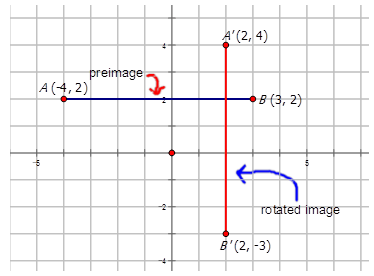
Now, let's draw and label the rotated image for the following rotations:
- The diamond \(ABCD\) is rotated \(145^{\circ}\) CCW about the origin to form the image \(A′B′C′D′\).
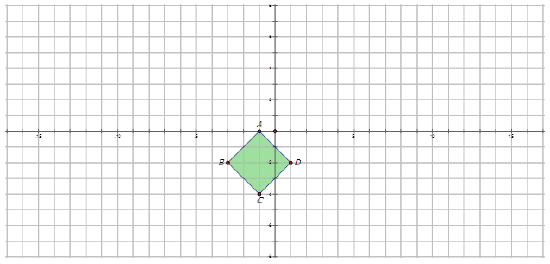
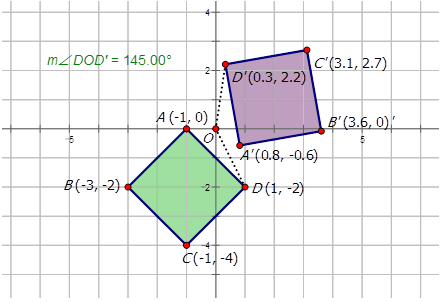
Notice the direction is counter-clockwise.
- The following figure is rotated about the origin \(200^{\circ}\) CW to make a rotated image.
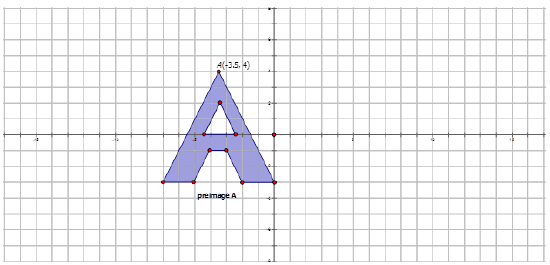
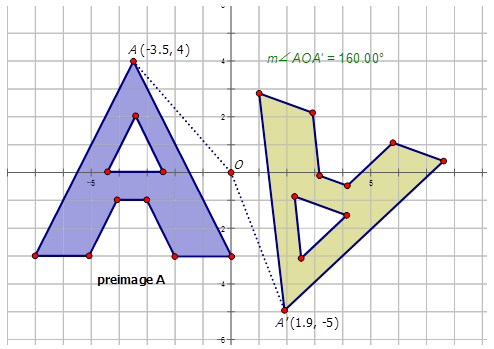
Notice the direction of the rotation is counter-clockwise, therefore the angle of rotation is \(160^{\circ}\).
Example \(\PageIndex{1}\)
Earlier, you were asked about the quadrilateral \(WXYZ\) has coordinates \(W(−5,−5)\), \(X(−2,0)\), Y(2,3)\) and \(Z(−1,3)\). Draw the quadrilateral on the Cartesian plane. Rotate the image \(110^{\circ}\) counterclockwise about the point X\). Show the resulting image.
Solution

Example \(\PageIndex{2}\)
Line \(\overline{ST}\) drawn from \((-3, 4)\) to \((-3, 8)\) has been rotated \(60^{\circ}\) CW about the point \(S\). Draw the preimage and image and properly label each.
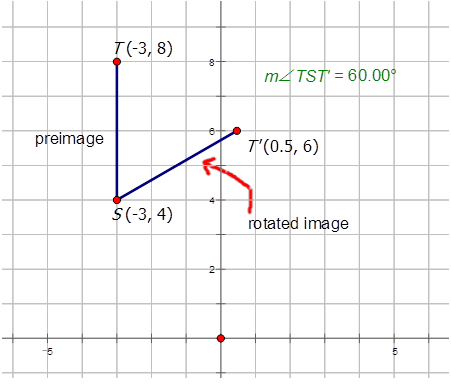
Solution
Notice the direction of the angle is clockwise, therefore the angle measure is \(60^{\circ}\) CW or \(−60^{\circ}\).
Example \(\PageIndex{3}\)
The polygon below has been rotated \(155^{\circ}\) CCW about the origin. Draw the rotated image and properly label each.
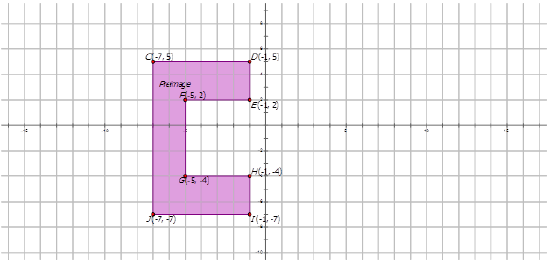
Solution
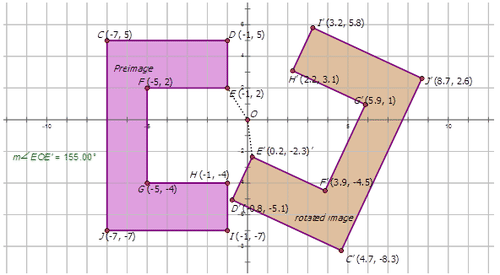
Notice the direction of the angle is counter-clockwise, therefore the angle measure is \(155^{\circ}\) CCW or \(155^{\circ}\).
Example \(\PageIndex{4}\)
The purple pentagon is rotated about the point A \(225^{\circ}\). Find the coordinates of the purple pentagon. On the diagram, draw and label the rotated pentagon.
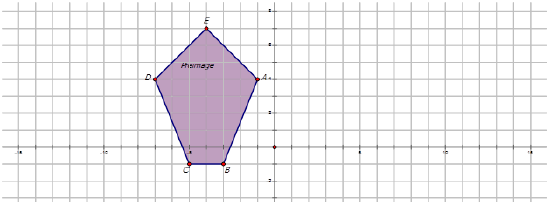
Solution
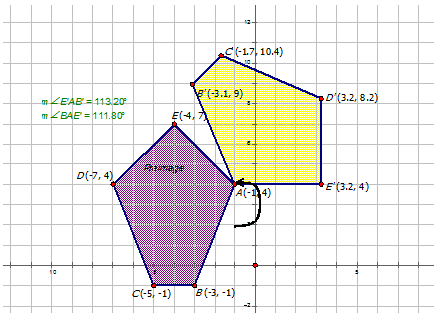
The measure of \(\angle BAB′=m\angle BAE′+m\angle E′AB′\). Therefore \(\angle BAB′=111.80^{\circ} +113.20^{\circ}\) or \(225^{\circ}\). Notice the direction of the angle is counter-clockwise, therefore the angle measure is \(225^{\circ}\) CCW or \(225^{\circ}\).
Review
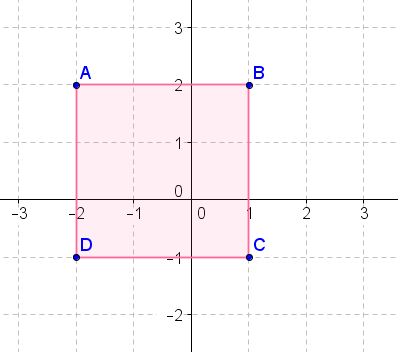
- Rotate the above figure \(90^{\circ}\) clockwise about the origin.
- Rotate the above figure \(270^{\circ}\) clockwise about the origin.
- Rotate the above figure \(180^{\circ}\) about the origin.
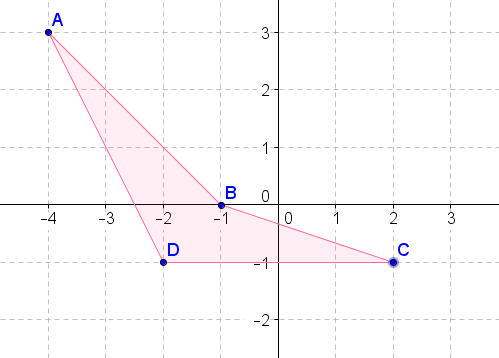
- Rotate the above figure \(90^{\circ}\) counterclockwise about the origin.
- Rotate the above figure \(270^{\circ}\) counterclockwise about the origin.
- Rotate the above figure \(180^{\circ}\) about the origin.

- Rotate the above figure \(90^{\circ}\) clockwise about the origin.
- Rotate the above figure \(270^{\circ}\) clockwise about the origin.
- Rotate the above figure \(180^{\circ}\) about the origin.
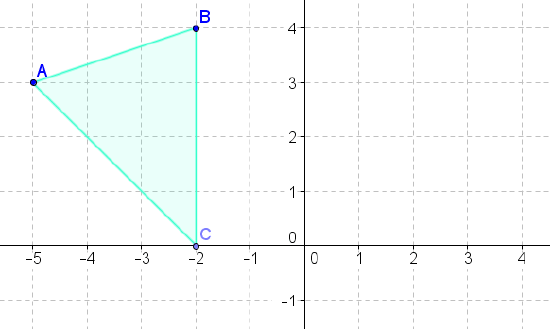
- Rotate the above figure \(90^{\circ}\) counterclockwise about the origin.
- Rotate the above figure \(270^{\circ}\) counterclockwise about the origin.
- Rotate the above figure \(180^{\circ}\) about the origin.
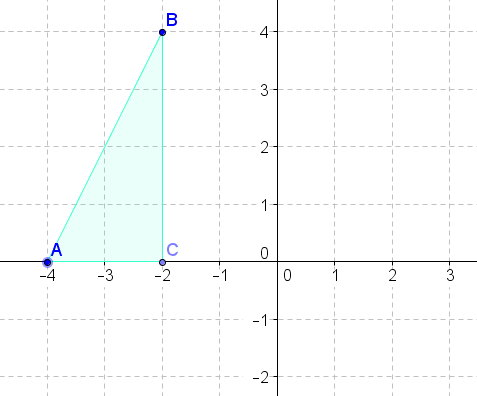
- Rotate the above figure \(90^{\circ}\) clockwise about the origin.
- Rotate the above figure \(270^{\circ}\) clockwise about the origin.
- Rotate the above figure \(180^{\circ}\) about the origin.
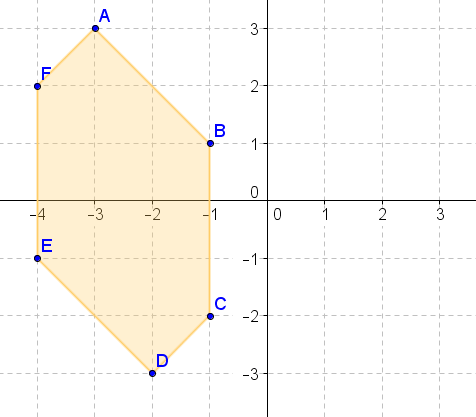
- Rotate the above figure \(90^{\circ}\) counterclockwise about the origin.
- Rotate the above figure \(270^{\circ}\) counterclockwise about the origin.
- Rotate the above figure \(180^{\circ}\) about the origin.
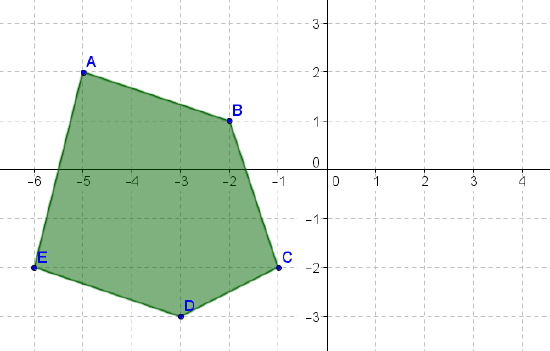
- Rotate the above figure \(90^{\circ}\) clockwise about the origin.
- Rotate the above figure \(270^{\circ}\) clockwise about the origin.
- Rotate the above figure \(180^{\circ}\) about the origin.
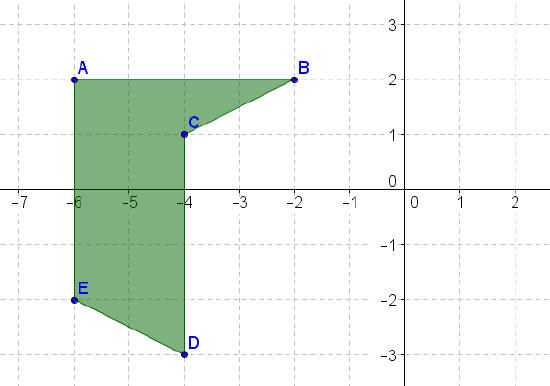
- Rotate the above figure \(90^{\circ}\) counterclockwise about the origin.
- Rotate the above figure \(270^{\circ}\) counterclockwise about the origin.
- Rotate the above figure \(180^{\circ}\) about the origin.
Review (Answers)
To see the Review answers, open this PDF file and look for section 10.8.
Vocabulary
| Term | Definition |
|---|---|
| Rotation | A rotation is a transformation that turns a figure on the coordinate plane a certain number of degrees about a given point without changing the shape or size of the figure. |
Additional Resources
Practice: Geometry Software and Graphing Rotations

